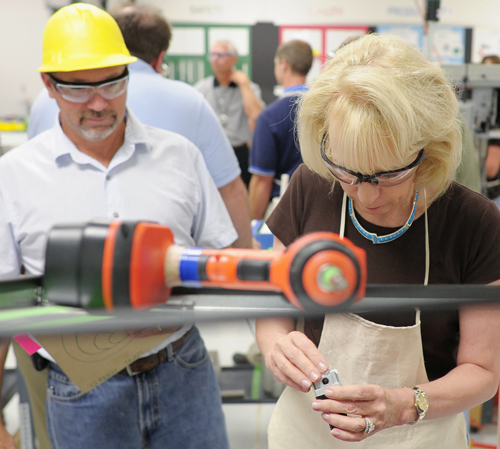
With 22 years at Toyota behind her, working up from assembly manufacturing supervisor to VP of Manufacturing Cheryl Jones has nothing to prove when it comes to the knowledge of lean systems. However that is not where she first realized that waste is often endemic, always bad for business and ultimately unfair. That came in a very different industry, when she was working as a checkout operator for Krogers, the American supermarket chain. Think about it, she says; the food industry has to operate on low profits, and if the product is to be within its sell-by date, just in time (JIT) delivery is essential.
Training for checkout staff, she recalls, focused on efficiency and how to scan product effectively and quickly. Throughput was measured, and staff worked, effectively, to establish a standard working practice. After eight years she moved to Toyota as we have seen, but even after a stellar career there, she confesses she didn’t quite realize when she moved into teaching how low the awareness of lean principles was throughout USA business. “I thought that was how every company was run!”
Well, it is not, and that is one reason for the success of the Lean Systems Program, started in the 1990s by Toyota and the University of Kentucky’s College of Engineering to study and share true lean.. “When I came to the university I had the chance to get into a large number of other companies and see how they do things. I still can’t say I truly know why companies differ so much, but it appears to me the more profit there is, the easier it is to tolerate waste internally!”
With a big profit margin there is not the pressing need to look at the very fine details and eliminate waste. Toyota itself learned this lesson the hard way, having teetered on the brink of bankruptcy back in 1949. It survived by paring its operations to the bone when Taiichi Ohno, and Eiji Toyoda developed the Toyota Production System (TPS) and consciously maintained that approach even in times of surplus. “You always felt, though the company was profitable, that money was scarce and we were broke! Now when I go into companies in aerospace, rail, or transportation to name just a few, I find many of them have a history of so much waste that they can’t even see it! There is so much improvement they could achieve if they had the Toyota mindset.”
There’s a tendency to be inward looking when it comes to process improvement, but Jones always sees the bigger picture. Certainly, any company that has been returning big profits to its shareholders, generously compensating its people – especially management –and growing steadily, can lose sight of the waste it creates. But that mindset is bad for the nation as a whole, she says. “When the economy dropped off people started to think about saving money but now that we seem to be getting back into growth, my hope is that we keep that focus. The more people think about efficiency the better for the US economy – and the global economy too.”
Another mistake many companies make, she continues, is to get sidetracked when taking a blinkered view of cost as related to profit. They may have some idea of workflow and operational efficiency, but unlike Toyota they haven’t lived with it enough to make it part of everyday operations. It especially upsets her when she sees the kneejerk reaction much of industry has once it feels the squeeze imposed by economic contraction and unfavorable exchange. They lay off staff. “It tears at my heart when they cut labor to reduce cost before eliminating waste in other areas. Of course it works short term but if you have so much waste in other areas you’d be better using the labor to reduce the waste!”
So what is the answer? “At the university we encourage companies to start at the top. In some of the most successful companies making this transformation, leadership rolls up their sleeves and changes what they do.” The problem is hands off management rather than top heavy management, she believes. Executives need to manage, but not in isolation. They need to understand they’re the ones who can help solve problems identified at the shop floor or out in the field. That requires their direct involvement and the resulting data to identify both the problem and the solution.
Much of her work is to teach companies eight-step problem solving leading to work standardization, but standard work is not in itself a tool for problem solving. She warns, “Managers like standardization because they see it as a way to address quality issues, but it is not a solution in itself.” The problem solving process should precede the standardization process. Standard work will then make future events easier to handle. She cites a recent discussion with a surgeon who had really tried to embrace the principles of standard work. “He said: ‘the more everyone understands what their role is, what they should be doing, and the procedures we should follow, the more it helps me when we have a problem.’ He was really beginning to get it!” In this case, standard work made life easier in the hospital but it also improved the patients’ experience and their confidence. As a result they can be less hung up on getting the best surgeon because they know they are in the best process!
Cheryl Jones has two young granddaughters and whatever they end up doing she wants them to have the widest possible choice. “When I first went to Toyota there were no other women working in manufacturing in Japan. Now they have more female engineers and managers, but most manufacturing companies still struggle with females and diversity.” A meeting with the Oscar winning actress Geena Davis encouraged her to think about reasons why girls rarely see engineering as an option. Davis had founded her Institute on Gender in Media which set out to work collaboratively with the male-dominated entertainment industry to dramatically increase the presence of female characters in media aimed at children, and to reduce stereotyping of females. If that battle still has to be fought in the media, it has hardly been joined when it comes to industry, Jones believes.
But she remains optimistic. One of the girls was given a small piece of equipment that injection-molds a small part – It molded her mind as well and impressed the child enough to make her say she wants to become an engineer! Her older grandchild plays Minecraft, which is a complicated building game that she loves, and which develops dimensional thinking. You don’t have to give up interest in the things that fascinate girls like nail polish and make-up, she says, but why not encourage an interest in what these things are made from and by what processes? With one of the 2005 Automotive News Top 100 Women in the Automotive Industry for a grandmother, the girls could hardly have a more positive role model.
Don’t be afraid of lean concepts, she concludes. Lean is a Toyota concept not a ‘Japanese’ concept. “Toyota grew it from best practices in other industries like food, or the military. They pooled it to find the most effective way to run their company. They are constantly reviewing and revising it, and looking at what other people are doing. Lean thinking has constantly changed, even within Toyota. If you are always building in continuous improvement you are building the culture you want long term. It is not the tools that make us lean; it is the way we approach the business.”












